Some people say that there’s a very fine line between unparalleled genius and unquestionable madness. As I stood outside the Temple of Sagrada Familia, the most visited tourist attraction in Barcelona, stupefied by the fantastical quality of the imposing façade reaching up to the sky, I certainly believed in the idea. It looked right out of a fairytale or a period film, except I wasn’t sure which period it would be set in.
I knew nothing about Gaudi, modernism or his revolutionary brand of architecture but I knew one thing as my mind tried to absorb the impossible enormity of the structure that stood before me- I would never see another man-made creation whose first sight would amaze me to a state where my mind couldn’t churn out any more thoughts. Not even a ‘This is unbelievable,’ or ‘How on earth”.
This was confirmed as I stepped inside the Sagrada Familia (immediately when I arrived, thanks to my Fast-track ticket) and my eyes at once fell on the colored stained glass windows and the myriad shapes and patterns above me; the branched columns and leaf-like details with light glimmering into the interior made me think of a forest sanctuary. For the first few minutes, I couldn’t think, photograph or listen to the audio guide; all I could do was look around and above.



On my travels, I have been fortunate to see some truly incredible structures created by man, from the Hagia Sophia in Istanbul to mirror and glass adorned palaces in Jaipur, but it’s hard to explain why I believe that the Sagrada Familia may be the one that will have had the greatest effect on me. The best I can do is to say that the forest-like interior of the basilica feels alive, just like the woods Gaudi envisioned when he was creating the space.
I spent the next few hours inside touring with the aid of the excellent audio guide, photographing and often sitting for a few minutes to reflect and introspect in a space that was built chiefly for that purpose by Catalan architect Antoni Gaudi.
Plan your Spain trip
- Browse hotels on Booking.com or Hotels.com
- Book a private transfer with Welcome Pickups
- Book tours and day trips with Get Your Guide
- Browse flights on Skyscanner
- For digital nomads, SafetyWing Insurance is currently the best option
About Antoni Gaudi
Born into a family of coppersmiths in Tarragona in 1852, Antoni Gaudi gained a reputation for his unconventional techniques when he studied at the School of Architecture in Barcelona. He took inspiration from nature and applied these ideas to architecture and design in a way that was unique and unheard of.
Though his work was considered much ahead of its time (and is still considered much ahead of our time), this did not deter the Catalan bourgeoisie, who impressed by his originality and creativity, assigned important work to him, many of which continue to grace Barcelona’s treasure trove of architectural masterpieces.
He first began to work on the design of the Temple of the Sagrada Familia in 1883, taking over the reigns from architect Francesc de Paula Villar, making it his sole project in 1914 and continuing to work on it until 1926 when he was run over by a trolley and died. He was buried in the chapel of Our Lady of Mount Carmel in the crypt of the Sagrada Familia.
Most people (including me) find it surprising that the Sagrada Familia is a work-in-progress, even after work first began on it 133 years ago. When Gaudi first came up with the design of the temple, he was well aware that it wouldn’t be completed during his lifetime. He famously joked that his client (God) wasn’t in a hurry. With advanced construction techniques, it is now expected that work on the basilica will be completed by 2030.
“It is not a disappointment that I will not be able to finish the temple. I will grow old, but others will come after me. What must be always preserved is the spirit of the work; its life will depend on the generations that transmit this spirit and bring it to life.” -A. Gaudí
About the Sagrada Familia
The Expiatory Temple of the Sagrada Familia, Gaudi’s most ambitious, opulent and often controversial project was ironically meant to be a ‘Cathedral for the Poor’. During the final years of his life, Gaudi was dedicatedly focused on its construction, prayer and fasting, and living a simple life of devotion.
Over the years, the structure has been described in interesting ways ranging from “one of the most hideous buildings in the world” by George Orwell to “terrifying and edible beauty” by Salvador Dali. There are many who are unable to see beyond the larger-than-life appearance of the Sagrada Familia and are suspicious of its integrity to its own purpose, believing that a place of worship does not require a grandeur of its scale.

The architectural elements brought together Gaudi’s religious beliefs with his inspiration from nature and applied these to convey the meaning and significance of the Sagrada Familia as a place of worship and faith using Christian iconography, sculpture and design.
Though he was inspired by Gothic and Byzantine design, he worked at bettering some of their shortcomings by creating self-supporting structural elements such as hyperboloids, paraboloids and double-twisted columns. He tested his new architectural methods using models in his workshop, a practice that is continued by Gaudi’s successors.
In the Sagrada Familia, as in the rest of his work, Gaudi’s appreciation and careful observation of nature is obvious. The branched columns and hyperboloids of the arches inside the basilica remind one of sunlight glimmering into thick woods through the leaves of towering trees. The spiral staircases inspired by the natural design of a snail are another such feature.

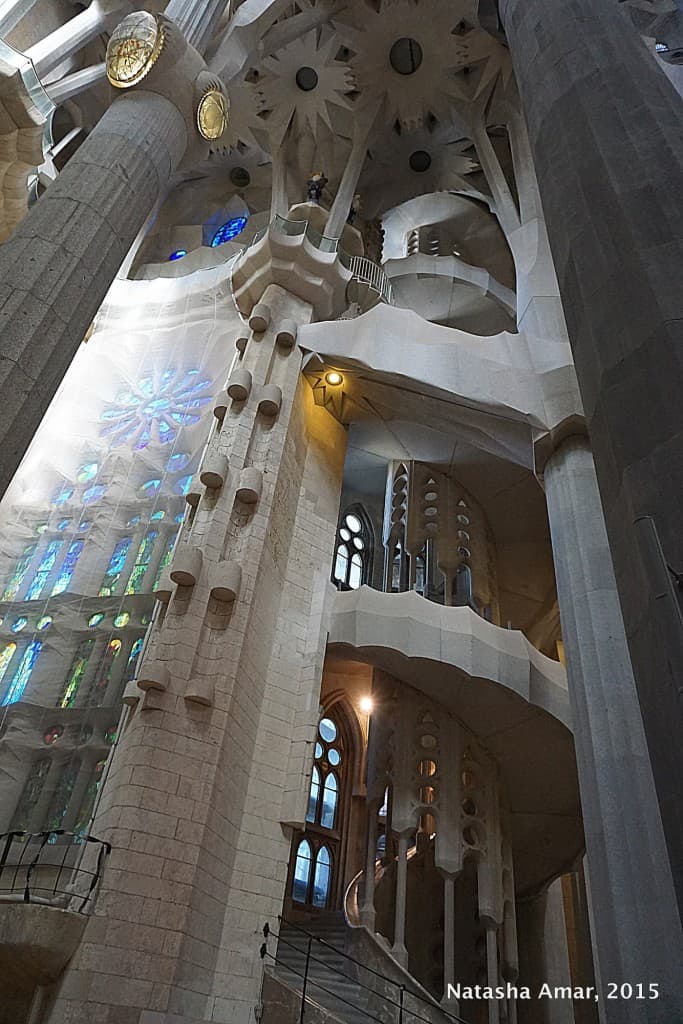
He designed the stained glass windows and the skylights to create an environment that nurtures self-reflection and prayer. The rising sun lights up the Nativity façade while the setting sun highlights the theme of the Passion façade. The liberal use of color, not only in the stained glass, but also in the use of ceramic, stones and tiles is unusual for its time.



The construction of the crypt and the Nativity façade were completed during Gaudi’s lifetime and have been declared a UNESCO World Heritage Site. The work on the basilica is funded by private donations and tourist entrance fees. The Sagrada Familia is not a cathedral, as it does not house an archbishop but in 2010, it was consecrated as a basilica (a church upon which certain ceremonial rights are conferred) by Pope Benedict XVI.
The completed structure, as per Gaudi’s directions, will have 18 towers, 12 shorter ones to represent the Apostles and six taller ones, the tallest of which will represent Christ. At a height of 172.5 meters, the basilica will be the tallest church in the world but will remain a few meters below Montjuïc – the highest point in the municipality of Barcelona, to show Gaudi’s respect for the work of God.
If you’re traveling around Spain, you’ll find this list of souvenirs to buy in Spain useful.
Visiting on a budget? Here are some party hostels in Barcelona.
More Photos of La Sagrada Familia

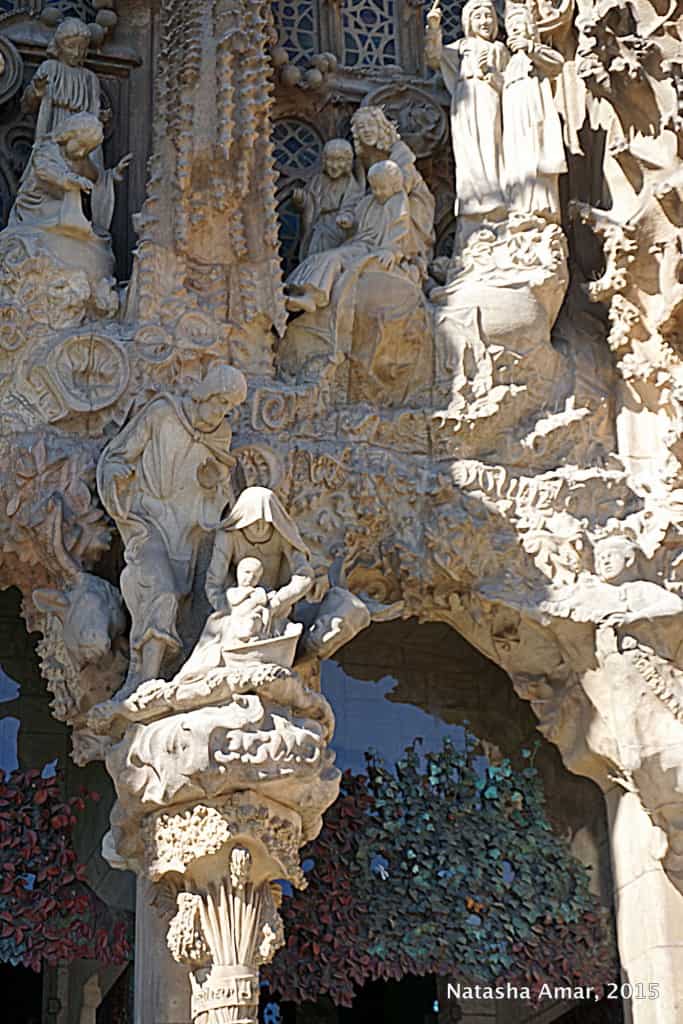
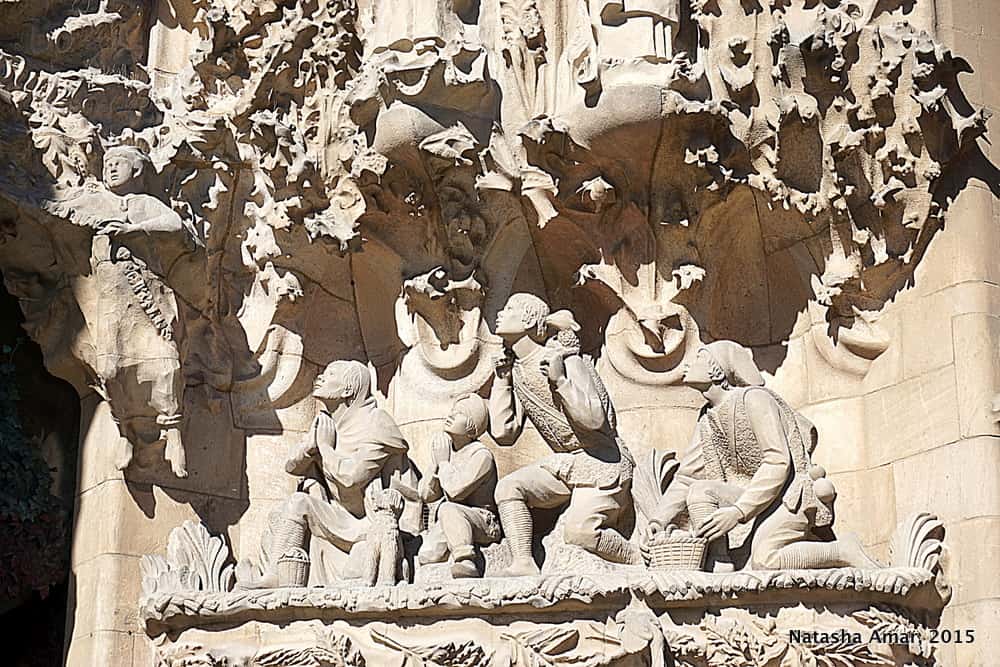




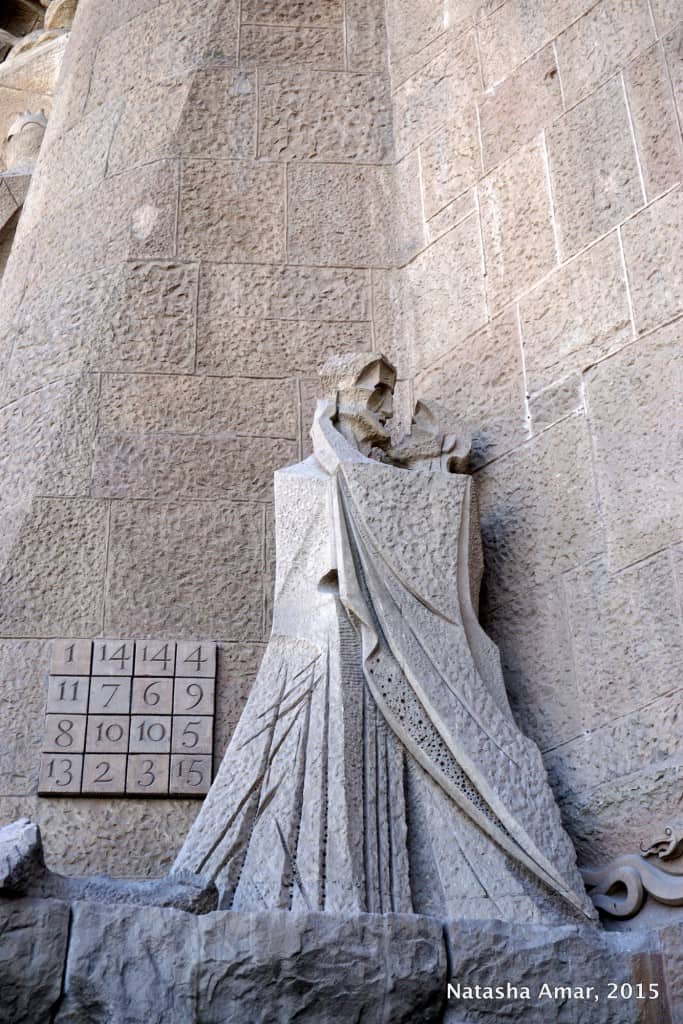
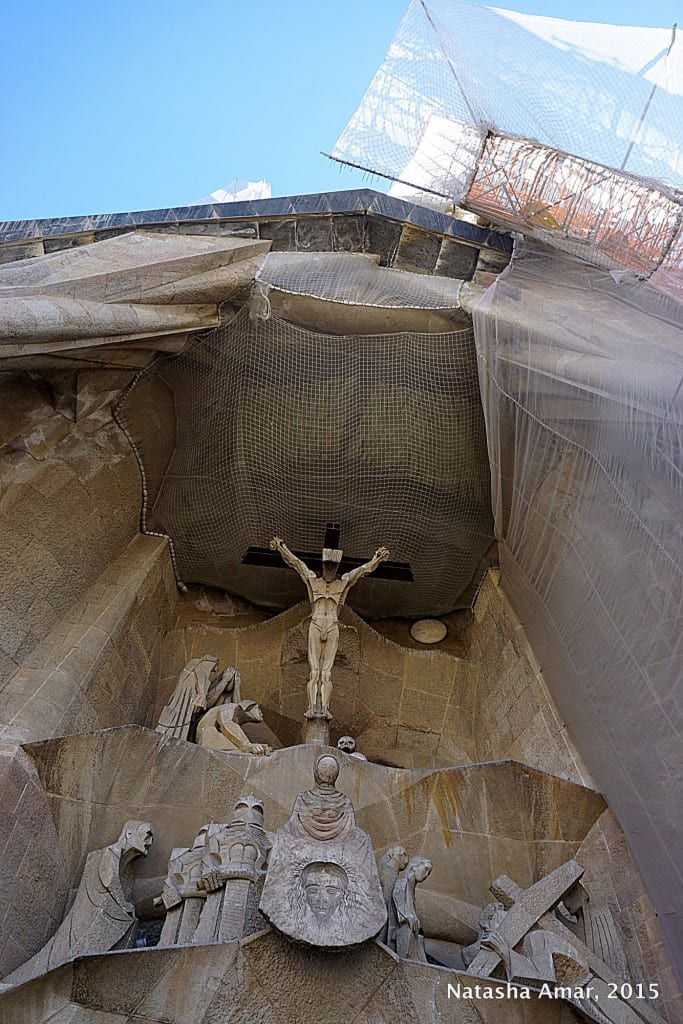




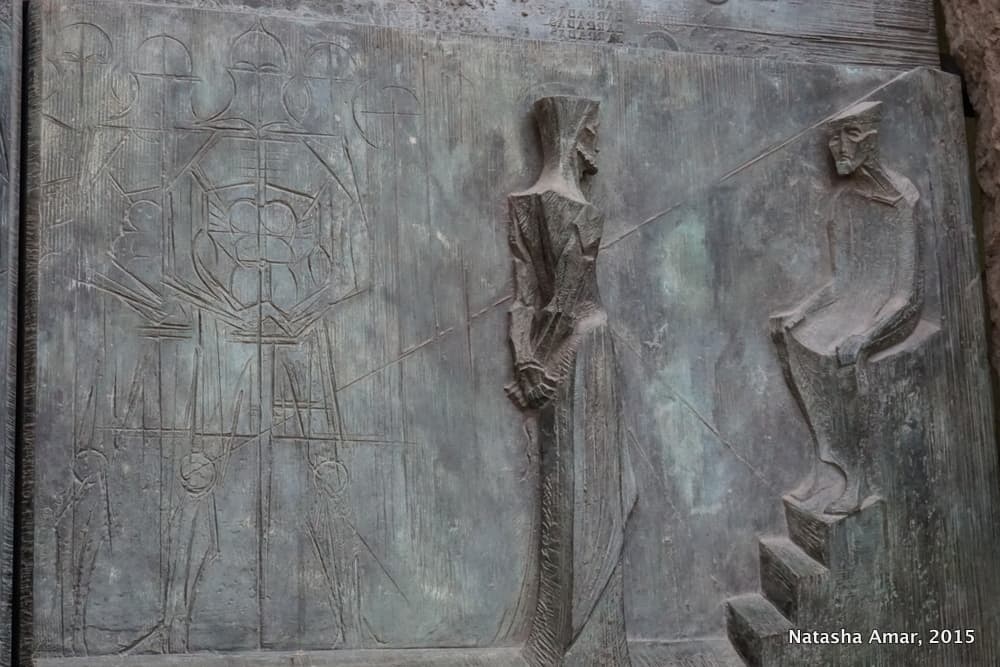


Tips for visiting La Sagrada Familia
- Book your tickets online and avoid waiting in queue for an hour or more. I booked mine using this option on GetYourGuide.
- It’s worth paying extra to visit one of the bell towers for great views over Barcelona.
- Give yourself at least two hours to visit. The Sagrada Familia is not the kind of place you want to rush through. I took four hours and while I might have taken my time, I wouldn’t recommend anyone to zip through it in an hour and move on to the next place.
- It’s worth taking the audio guide to understand the inspiration and significance behind the design and architecture.

For more info, check the official website of La Sagrada Familia.
Plan your Spain trip
- Browse hotels on Booking.com or Hotels.com
- Book a private transfer with Welcome Pickups
- Book tours and day trips with Get Your Guide
- Browse flights on Skyscanner
- For digital nomads, SafetyWing Insurance is currently the best option
For general information to help you plan your travels to Spain and suggested itineraries, check out these posts.
Unearthing Barcelona’s Best Kept Secret in the City of Chocolate
La Sagrada Familia: Gaudi’s Unparalleled Genius in Barcelona
Tasting Gràcia: A Walking Food Tour with Devour Barcelona
Cap De Creus: Finding ‘Brava’ on Spain’s Eastern Tip
Girona: The Colors of a Medieval Town
On My Plate In Costa Brava: What to Eat & Where
Flors i Violes: Celebrating Spring in Palafrugell
In Conversation with Pedro Burruezo, Musician, Environmentalist & Pioneer
La Casa Magica: House of Curiosities in Costa Brava
This post contains affiliate links. If you make a purchase using these, I might get a small commission with no extra cost to you, which goes towards running this site.

Meg Jerrard
Monday 28th of December 2015
Beautiful photos! It really is a masterpiece isn't it!!
Great tip on pre purchasing tickets online before you go - Ive seen that line often stretch around the block before! I would also add for travelers to remember to dress appropriately to gain entrance to the church. The dress code requires no bare shoulders, and no shorts or skirts above the knee. You would be surprised what some tourists deem acceptable to wear inside a church! Don't want to be denied entry otherwise :)
Natasha Amar
Monday 28th of December 2015
Good point Megan.
Bobbi
Monday 28th of December 2015
Holy WOW! You know what.. there is a thin line between genius and insanity and of that's insane, I'll take it over normalcy any day of the week. I'm enamored. Thanks for this great post!
Stefan
Sunday 27th of December 2015
Absolutely love the Sagrada Familia (well anything by Gaudi to be honest). One tip I'd give is its definitely worth investing in the headphones audio guide when visiting. I went twice. The first time a bit lost/overwhelmed, the second time the headphones really helped and made it more memorable as you understand each detail better. Love your photos by the way - great job!
Natasha Amar
Sunday 27th of December 2015
Thank you Stefan!
Ryan Biddulph
Monday 19th of October 2015
Hi Natasha,
Jaw-dropping stuff. The photos really do make one feel like the place is alive, not some structure.
Ryan
Natasha Amar
Monday 19th of October 2015
Thanks Ryan :)
Dave from Daves Travel Pages
Sunday 18th of October 2015
Fabulous photos which have really captured the eccentricity of it all!!
Natasha Amar
Sunday 18th of October 2015
Thank you Dave!